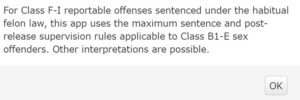
About seven years ago, I wrote this post about habitualized sex crimes. The issue I explored there was how to sentence a person convicted of a Class F through I sex crime when he or she has also attained habitual felon status. The question is whether the defendant, who is now sentenced as a Class B1 through E felon due to the habitual felon law’s four-class enhancement, is subject to the elevated maximum sentence applicable to Class B1 through E sex offenders under G.S. 15A-1340.17(f). When I wrote that post there was no appellate case answering the question. There is now.
In State v. Essick, 2022-NCCOA-131 (Mar. 1, 2022), the defendant was convicted of third-degree sexual exploitation of a minor, a Class H felony that requires registration as a sex offender. He also pled guilty to being a habitual felon, elevating the punishment classification from Class H to Class D. When it came time for sentencing, the trial court imposed a 67–141 month sentence, concluding that the rule in G.S. 15A-1340.17(f) (the maximum sentence is 120 percent of the minimum plus 60 additional months) should apply to a low-level felony sex offender sentenced as a Class D felon under the habitual felon law.
Through a petition for writ of certiorari, the defendant argued in the Court of Appeals that the sentence should have been 67–93 months. He thought the “regular” maximum sentence (120% of the minimum plus 12 additional months) should have applied, because an enhanced Class H sex crime is not actually covered by the language of G.S. 15A-1340.17(f).
The Court of Appeals agreed. The habitual felon statute, G.S. 14-7.6, says that a covered defendant is “sentenced at a felony class level that is four classes higher than the principal felony,” (emphasis supplied), but, the Court reasoned, it does not actually reclassify or transform the principal felony into a more serious offense. Rather, the principal felony retains its character as a Class H felony. And therefore, the Court concluded, it is not covered by G.S. 15A-1340.17(f). That law applies to defendants “sentenced for a Class B1 through E felony that is a reportable conviction,” not to defendants merely sentenced as Class B1 through E felons by virtue of the habitual felon law.
The bottom-line rule, then, is that the elevated maximum sentence rule for sex offenders in G.S. 15A-1340.17(f) applies only to sex crimes that fall in Classes B1 through E “naturally,” and not solely by virtue of a sentence enhancement. Crimes enhanced into Classes B1 through E should receive the ordinary, non–sex offender maximum sentence.
There are several wrinkles worth pointing out. First, the Court’s interpretation in Essick does not mean that no sex offender sentenced under the habitual felon law gets the 60-month maximum sentence enhancement. If the principal felony is already a Class B1 through E felony, it gets the elevated maximum sentence even if it is enhanced under the habitual felon law. So, for example, Class E second-degree sexual exploitation of a minor elevated to Class C under the habitual felon law does get the enhanced maximum sentence, because the underlying principal felony falls within the coverage of G.S. 15A-1340.17(f).
Second, the habitual felon law does not fully remove the sex crime character of any enhanced principal felony. For instance, even though the elevated maximum sentence rule does not apply to an enhanced low-level felony, those defendants will still be subject to 5 years of post-release supervision, because that rule applies to any felony that requires registration, not just those in Classes B1 through E. G.S. 15A-1368.2(c). The defendant will also be subject to the special conditions of probation or post-release supervision that apply to sex offenders, as those conditions are not limited to defendants in certain offense classifications. See G.S. 15A-1368.4(b1) (PRS conditions for sex offenders).
Third, I imagine Mr. Essick is not the only defendant who has been sentenced to what we now know to be an incorrect maximum sentence. Other defendants might now have a valid grounds for a motion for appropriate relief based on an invalid sentence. G.S. 15A-1415(b)(8).
Finally, I should note that the analysis I applied in my blog post back in 2015 turns out based on Essick to have been incorrect. Moreover, I programmed that incorrect thinking into the Structured Sentencing Mobile Application available at ncsentencing.com. Under the rules we programmed into the app back in 2013, if you select a Class F–I felony, make it a sex crime, and enhance it under the habitual felon law, the following warning pops up:
 So, good for me for anticipating the issue and flagging that other interpretations might be possible, but shame on me for choosing a default interpretation that turned out to be wrong. We’ll incorporate the clarified rule from Essick into the app soon.
So, good for me for anticipating the issue and flagging that other interpretations might be possible, but shame on me for choosing a default interpretation that turned out to be wrong. We’ll incorporate the clarified rule from Essick into the app soon.
